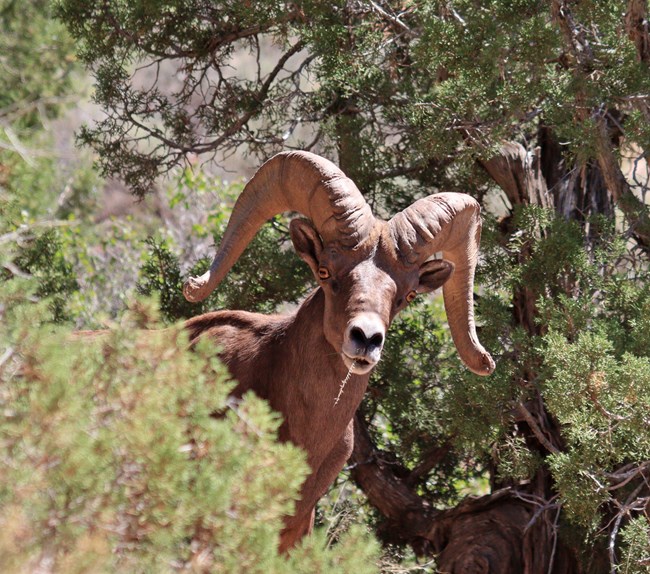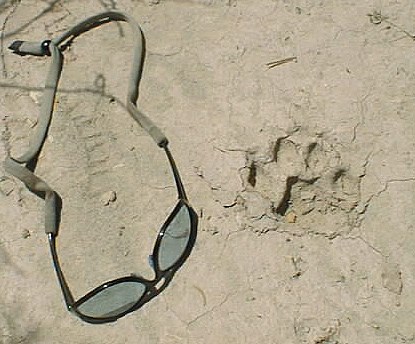
VIP Carla DeKalb Most of the mammals that live in Colorado National Monument on a year-round basis have evolved unique physical and behavioral adaptations to survive in this semiarid ecosystem. Annual precipitation at Colorado National Monument is less than 12 inches a year with summer temperatures ranging from the high 90s to over 110 degrees in the canyons. Winters are generally mild with lows occasionally dropping to the single digits. These extremes, combined with a minimal amount of water, can prove to be challenging to wildlife. A majority of mammals like the desert cottontail, mule deer, coyote, porcupine, black-tailed jackrabbit, and many songbird species are crepuscular, meaning they are only active in the early morning hours or late in the evening when temperatures are cooler and there is just enough light to forage for food. Others, like the ringtail, fox, bobcat, mountian lion, several species of bats, and a variety of small desert rodents, are nocturnal (emerging at night) and are rarely seen. Mammals like rock squirrels, antelope squirrels, and Hopi chipmunks are active during the daytime or "diurnal" and are a common sight. Of course, there is the occasional rare and exciting report of a mountain lion wandering in one of the canyons or, as was the case in the summer of 1997, a black bear sleeping in Window Rock! Over 40 species of mammals have been recorded within the boundaries of the monument; however, not all are year-round residents. The desert bighorn sheep are frequently seen near the Balanced Rock area on the west side of the park. Elk have also been known to travel down to the monument from the higher elevations during the winter months. 
VIP Marcia Snyder Common Mammals in the Monument Coyote (Canis latrans) – These medium-sized members of the canid family are commonplace in the American West. Coyotes average about 15 inches in height (at the shoulder) and range from 15 to 44 lbs in weight. They are primarily nocturnal, but they can sometimes be spotted roaming in daytime. As an omnivore, they will eat almost anything, but small rodents and rabbits typically comprise the bulk of their diets. Coyotes breed in the winter and typically give birth to 4 to 7 pups in early spring. This inquisitive and opportunistic animal is the best runner of the canids, reaching speeds up to 30 miles per hour. They are able to leap up to 14 feet in a single bound. Grey Fox (Urocyon cinereoargenteus) – The grey fox ranges through most of the southern half of North America. These small members of the canid family resemble small dogs with bushy tails. Grey foxes are solitary hunters and eat a wide variety of food, including rabbits, voles, mice, and birds; they also supplement their diets with fruits when they are available. Grey foxes are unique among canids in that they are able to climb trees. They have strong, hooked claws that allow them to scramble up trees to avoid predators or to get fruit. Grey foxes are nocturnal and den during the day in hollow trees, stumps, or old burrows. Ringtail (Bassariscus astutus) – This cat-sized carnivore resembles a small fox with a long raccoon-like tail. Its tail is typically as long as its body and is banded with 14 to 16 alternating black and white rings. Ringtails live in a variety of habitats, but have a preference for rocky areas, canyon walls, and talus slopes. They are expert climbers, capable of climbing vertical walls. Ringtails are nocturnal and spend most of the day asleep in dens, typically in rock crevices and hollows. They eat a wide variety of animals, including small mammals, birds, reptiles, amphibians, and insects, but they also supplement their diets with fruit, including juniper berries, in winter. Rabbits and Hares (family Leporidae) – Worldwide, there are almost 50 species of rabbits and hares, most of which are native to North America. At Colorado National Monument, desert cottontails (rabbits) and black-tailed jackrabbits (they are actually hares) are common. They are generally grazers, feeding on grasses and other plants, but they may also feed on twigs and tree bark. While these two groups of mammals are often confused, they are actually quite easy to identify. Rabbits are generally smaller and have relatively smaller ears. Hares have very large ears and long hind legs. Typically, rabbits are weak runners, and when threatened, they often scamper into thick brush. Hares, on the other hand, are more adapted to open country, are very strong runners, and usually burst into bounding runs when threatened. Both groups have high reproductive rates; their litters typically consist of up to eight young, and can be as large as 15. Porcupine (Erethizon dorsatum) – These large members of the rodent family have long, pointed spines, or quills, growing from their backs and sides. The quills have needle-sharp ends and hundreds of barbs. They are loosely attached and can be raised by the muscles of the skin. Porcupines can be found in wooded areas throughout North America, from Alaska to Mexico. They are herbivorous that often eat the bark of trees. They grow to a length of about 26 inches, and have short tails and brownish hair that almost conceals their two to six inch quills. Bobcat (Lynx rufus) – These medium-sized cats live in shrubby country and broken forests and are fairly common in the monument. Bobcats are about 25-30 inches in height (at the shoulder), and range in weight from 9 to 40 pounds. They are gray-brown with distinctive black spots, and have short "bobbed" tails that are about four inches long. Bobcats are skilled predators. Their prey include rodents, rabbits, hares, squirrels, and birds. They are excellent climbers and often wait in trees to pounce on their prey. Mountain Lion (Felis concolor) – Mountain lions, also commonly known as cougars and pumas, range from northern Canada to the tip of South America. They are large, powerful cats, standing 28 inches (at the shoulder) and weighing up to 200 pounds. Despite their large size, they are very quick and agile; mountain lions can cover up to 23 feet in a single leap. However, because they tire quickly, they must be accurate; if prey is able to survive initial attack, it will normally escape. They generally hunt in the daytime by stalking and pouncing on the back of their fleeing prey. Once they power their prey to the ground, they normally deliver a fatal bite to the back of the neck. Their principle food source is deer. |
Last updated: February 27, 2023
